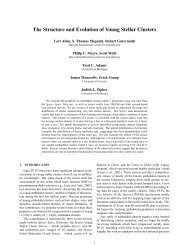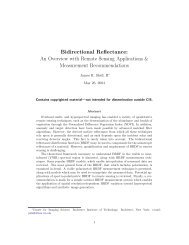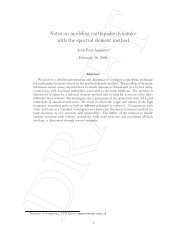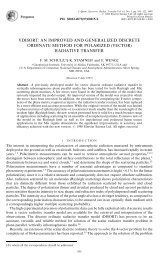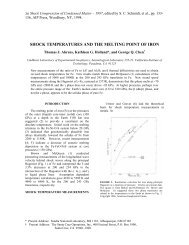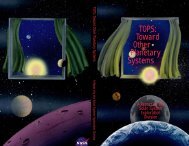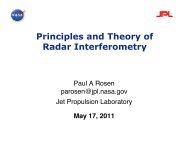VLIDORT User's Guide
VLIDORT User's Guide
VLIDORT User's Guide
Create successful ePaper yourself
Turn your PDF publications into a flip-book with our unique Google optimized e-Paper software.
1.1.2. Development of Linearized Vector RT modelsIn the last fifteen years, there has been increasing recognition of the need for RT models togenerate fields of analytic radiance derivatives (Jacobians) with respect to atmospheric andsurface variables, in addition to simulated radiances. Such “linearized” models are extremelyuseful in classic inverse problem retrievals involving iterative least-squares minimization (withand without regularization). At each iteration step, the simulated radiation field is expanded in aTaylor series about the given state of the atmosphere-surface system. Only the linear term in thisexpansion is retained, and this requires partial derivatives of the simulated radiance with respectto atmospheric and surface parameters that make up the state vector of retrieval elements and thevector of assumed model parameters that are not retrieved but are sources of error in theretrieval.It is well known that the use of scalar radiative transfer (neglecting polarization) can lead toconsiderable errors for modeling backscatter spectra in the UV [Mishchenko et al., 1994; Lacis etal., 1998; Sromovsky, 2005]. Studies with atmospheric chemistry instruments such as GOME,SCIAMACHY and OMI have shown that the treatment of polarization is critical for thesuccessful retrieval of ozone profiles from UV backscatter [Schutgens and Stammes, 2003;Hasekamp et al., 2002]. The role of polarization has been investigated for retrieval scenariosinvolving important backscatter regions such as the oxygen A band [Stam et al., 1999, Jiang etal., 2003; Natraj et al., 2006]. It has also been demonstrated that the use of passive sensinginstruments with polarization capabilities can greatly enhance retrievals of aerosol information inthe atmosphere [Mishchenko and Travis, 1997; Deuze et al., 2000]; this is becoming a veryimportant issue as the scientific community tries to understand the effects of aerosol forcing[Heintzenberg et al., 1996; Mishchenko et al., 2004].Satellite instruments such as GOME-2 (launched in October 2006) [EPS/METOP, 1999] andOCO (Orbital Carbon Observatory) [Crisp et al., 2004] are polarizing spectrometers; vectorradiative transfer is an essential ingredient of the forward modeling component of their retrievalalgorithms. Vector RT modeling is slower than its scalar counterpart, and the treatment ofpolarization in forward modeling has often involved the creation of look-up tables of“polarization corrections” to total intensity. However, with the advent of new and plannedinstruments measuring polarization, there is a need for linearized vector models to deal directlywith retrieval issues.Historically, a number of linearized RT models were developed for the scalar RTE some yearsago [Rozanov et al., 1998; Landgraf et al., 2001; Spurr et al., 2001]. This includes the LIDORTlinearization (see below). Linearized vector radiative transfer models include the Gauss-Seidelcode [Landgraf et al, 2005 and reference therein], and the linearized <strong>VLIDORT</strong> model [Spurr,2006].1.2. Overview of the LIDORT and <strong>VLIDORT</strong> modelsIn this section we present a developmental review of the LIDORT and <strong>VLIDORT</strong> models. Insections 1.2.1 and 1.2.2 respectively, we summarize the earlier Fortran 77 versions up to the year2010 The most recent versions with re-organized codes and full Fortran 90 capability aresummarized separately in section 1.2.3.Table 1.1 gives a quick overview of the main developments and associated version numbers.8



